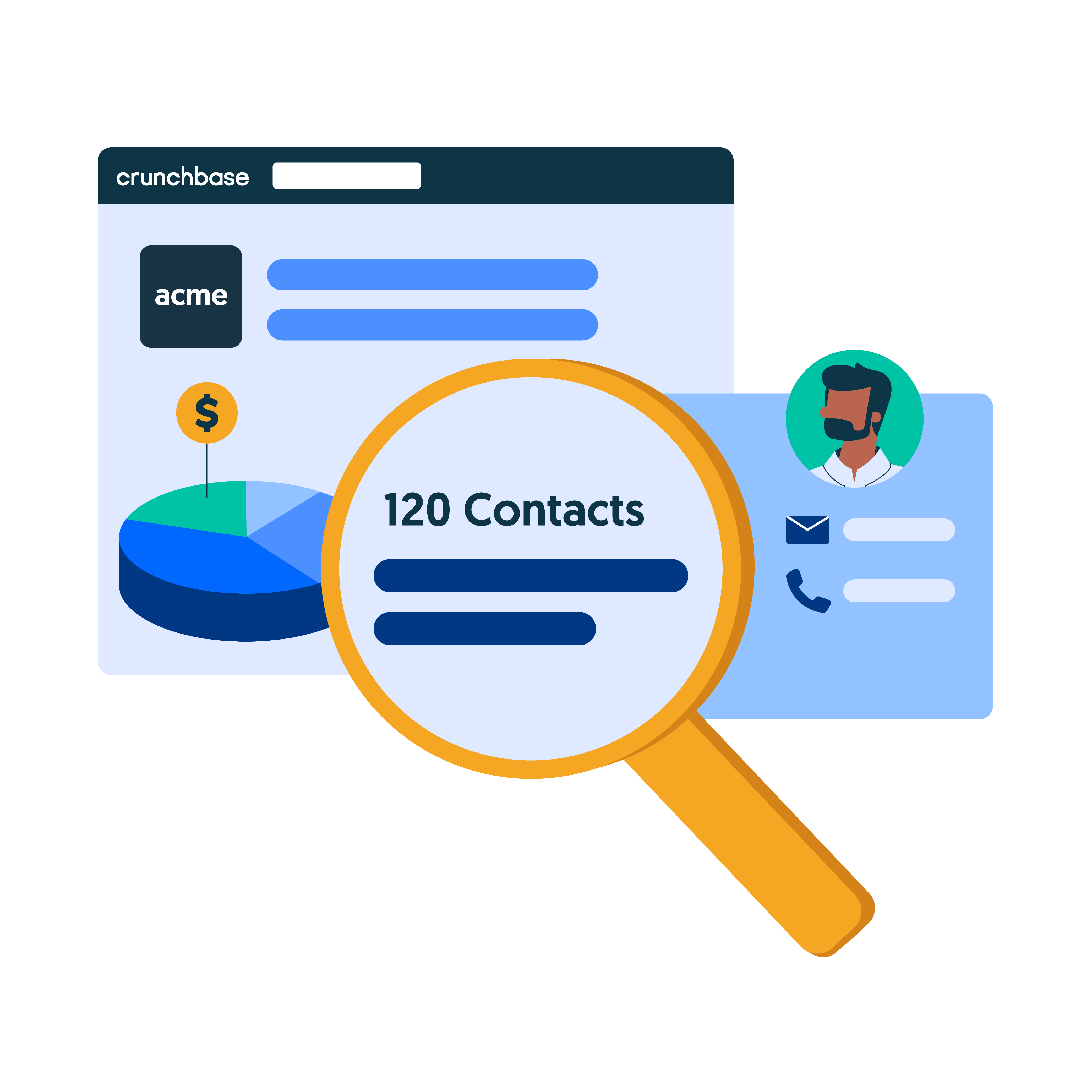This article is part of the Crunchbase Community Contributor Series. The author is an expert in their field and we are honored to feature and promote their contribution on the Crunchbase blog.
Please note that the author is not employed by Crunchbase and the opinions expressed in this article do not necessarily reflect official views or opinions of Crunchbase, Inc.
Hearing “no” over and over again can take a toll on anyone. As a salesperson, you’re used to hearing no in all its forms:
- “We’ll get back to you on that.”
- “We’ll call you when we have more time to discuss.”
- “Now isn’t a great time for our company.”
And you’ve probably heard dozens more just like that.
So how do you overcome sales objections? In this article, we’ll discuss everything you need to know to overcome sales objections, share tips on how you can respond to prospects, build a solid sales objection strategy, and close more deals.
Building your sales objection strategy
Winging your sales objection strategy is one option, or you could follow the steps below and build a sales objection strategy that works.
1. Listen to your prospects
It’s easy when you’re in the midst of the sales process to jump to your next talking point when your prospect starts objecting to your pitch. But it’s critical that you slow down and listen to their objections. Think of it this way: Even though they sound the same, no two common sales objections are alike.
Not only will listening help you overcome the sales objection, but it will show the prospect that you’re paying attention to what they’re saying. Prospects who receive pitches and cold calls frequently will appreciate being heard in the sales process.
Once you really hear what the prospect is saying, you can address their concerns. Let them know you hear and understand what they’re saying. If you don’t understand or the customer is being vague because they’re busy or uninterested, attempt a follow-up question to keep them engaged and gain more information.
2. Show empathy
Now let’s dig deeper. When you get a common objection from a prospect, take a moment to understand where they’re coming from and then ask them a few questions to get to the heart of their objection.
If a prospect tells you their business has other priorities, follow up by asking about their hunt for the best product or service. You’ll be showing an interest in their business and your product or service may be able to address one of those priorities in a way the prospect hasn’t considered.
By showing empathy, you’ll better connect with your customer and you may get the opportunity to address a need or question you wouldn’t have otherwise picked up on.
3. Overcome their objections
Once you’ve listened and empathized with your prospect, your next step is to handle the objection. After digging into the objection by asking follow-up questions, you’ll have a better understanding of what to say.
For example, if a prospect objects that the price is too high for your product or service, ask them what they would pay or what they think would be a fair price. From there, you can demonstrate and discuss the product’s value for the prospect.
If the sales process progresses, you can offer the potential buyer a discount down the road, showing them you listened when they were concerned about the price.
When handling an objection, determine the number of solutions you can offer them. Doing so will increase the prospect’s odds of finding one that works for them, thus increasing your odds of securing a sale.
And if they don’t bite? Don’t push them. You never know when a potential client may decide to reach out for a sales conversation.
The chart below shows what every sales rep already knows. Prospecting is the hardest part of the sales cycle.
Four ways to address the dreaded “Now is not the right time” objection
So, what are some ways to address the “now is not the right time” objection? We will go over this response and its variations, so you and everyone else on your sales team know exactly what to say when this very real objection undoubtedly comes up.
1. “When do you think you will be ready to buy?”
When you pose this question to your prospect, try not to display a sense of urgency. Chances are your potential client does want to buy your product or service but can’t afford to at the moment or wants to wait until the next quarter.
Whatever the reason, inquiring about their plans gives you an opportunity to set up a follow-up appointment. Just remember to follow up and reach out between meetings to check in and maintain the relationship.
2. “What will be different for your business next year?”
For this question, feel free to substitute next year for next quarter, next month, or whatever time frame the prospect gives you.
This question gives you a chance to find out what’s going on with their budget, goals, or other true issues. Worst case scenario? They’re just trying to brush you off and need to tell you something.
Here’s a look at other common sales objections you might encounter as a sales professional:
3. “Do you mind if I ask what your real concerns are?”
A bold move, but one that can help you master your sales pitch. If you get a typical sales objection like “now is not the right time,” just come out and ask what the prospect’s real concerns are. Hopefully, the prospect will tell you their actual objection.
If they do open up, you get a solid start to crafting your solutions for them. It also puts you both on even footing without the back and forth of vague answers and solutions that don’t work.
5. “What part of my product (or service) do you think would have the most benefit for your business?”
If you’ve gone over the features of your product or service and the prospect objects, ask them what features would benefit their business. This is an excellent way to remind them of the benefits without doing all the talking.
At the same time, having the prospect take the extra time to describe their business goals and what they’re looking for can clue you into any of their needs you may have missed in your initial pitch.
For example, if your prospect is looking for small business phone services and your video conferencing platform offers scalable pricing plans that work for small businesses, you might not know to highlight this feature until the prospect mentions it.
Tips for overcoming sales objections
Besides a solid strategy and open-ended questions to address sales objections, below are a few tried-and-true tips to help you overcome objections and enhance your selling strategy.
1. Focus on value from the beginning
After you’ve said hello and given the prospect your name, jump right into how your product or service can provide them incomparable value. One way to start this conversation and keep them interested is by doing your research on their company or general industry, then explaining how you understand the problems they are facing.
If they’re engaged in the pitch, go into the different ways your product or service can help them, focusing on the value they’ll receive. This is a great way to deter common types of objections. Potential clients will see value from the very onset, helping to build their relationship with your company.
And just for reference, here are some other principles of value-based selling to keep in mind:
2. Stand your ground
When you get on the phone with a potential customer, don’t give up on the first objection. Whether it’s a price objection, a timing objection, or a simple “no thanks.” Your prospect is busy and wants to get off the phone, but you want to keep them on. So be firm and stand your ground.
Have your sales team practice firm but friendly calls that aim to keep the customer on the line. Another strategy in the stand-your-ground wheelhouse is to ask the prospect for 30 seconds of their time.
Asking for 30 seconds gives you a chance to draw the prospect in without them feeling like they’re committing to an excessive amount of time.
3. Go off-script
Decision-makers at companies get cold calls and emails every day, so they’re familiar with the opening beats of cold prospecting strategies.
“Hi, this is [insert name] and I’m with [insert company], how are you today? Do you have a few minutes to discuss what [product or service] can do for your company?”
In the eight or 10 seconds it takes for a sales rep to get that introduction out, the prospect has already checked out and is ready to say, “Sorry, now is not the right time.”
So go off-script and change up the routine. Greet all of your prospects differently or stick to one completely out-of-the-box greeting that will leave your prospects wondering what else about your pitch is different. Shaking up your sales routine will keep it fresh and keep your prospects on their toes.
Bonus: Handling email objections
Email objections, by their very nature, are different and therefore have different guidelines. You can react instantly to a phone or in-person objection. When you receive an objection by email, you have more time to craft your response, but there are still some key points to keep in mind.
1. Be polite
When you receive a no in an email from a prospect, don’t take it personally. Only 23.9% of sales emails are opened on average, so be glad you’re getting a response.
When you respond, acknowledge the prospect’s decision and keep your tone polite and friendly. Remaining professional is key and will go a long way in maintaining a future relationship. Once you’ve acknowledged their decision, base your follow-up on their reasoning.
For example, if all they said was “no, thank you,” thank them for their time and move on. If they offer up an objection, respond with a tailored rebuttal that remains respectful of their reasoning, but include a solution or two and ask them if they want to discuss further over the phone.
Provide specific dates and times that you can talk or meet, so they have firm options.
2. Provide content and resources
If a potential customer sends back a response indicating they’re not sure what your product can do for them, send them a piece of content or resource from your business that can provide immediate value.
The content could be anything from a blog article with customer use stories or a webinar highlighting the value of your product’s features.
3. Keep your emails short and sweet
Handling objections on the phone is hard enough, but when you’re dealing with email as a sales tool, you’re getting an even shorter amount of attention from your prospects.
Keep your emails short, sweet, and to the point. Prospects will be more likely to read something that gets right down to business. If you need to make it a little longer, consider putting your email in bullet points so it’s easier to read.
Now is the right time
Coming up with replies to sales objections can be one of the most daunting aspects of the job—but it doesn’t have to set you back. You now have the tools to build a sales objection strategy and skillfully respond to any objection a potential client throws at you, whether on a call, in person, or in an email. You won’t win every pitch, but now you’ll know you did everything you could to turn that no into a yes.
Tanhaz Kamaly is a Partnership Executive at Dialpad, a modern cloud-hosted business communications platform that turns conversations into the best opportunities, both for businesses and clients. He is well-versed and passionate about helping companies work in constantly evolving contexts, anywhere, anytime.






